

This article needs additional citations for verification. Please help improve this articlebyadding citations to reliable sources. Unsourced material may be challenged and removed.
Find sources: "President of Estonia" – news · newspapers · books · scholar · JSTOR (October 2021) (Learn how and when to remove this message) |
| President of the Republic of Estonia | |
|---|---|
| Eesti Vabariigi President | |

Presidential Standard
| |
|
Incumbent Alar Karis since 11 October 2021 | |
| Style | Mr President (informal) His Excellency (diplomatic) |
| Type | Head of state |
| Residence | Presidential Palace, Tallinn |
| Appointer | Riigikogu / Electoral College (alternately until a candidate reaches the required majority) |
| Term length | 5 years, renewable once consecutively |
| Constituting instrument | Constitution of Estonia |
| Inaugural holder | Konstantin Päts |
| Formation | 24 April 1938; 86 years ago (1938-04-24) |
| Abolished | 1940–1991 |
| Deputy | Speaker of the Riigikogu |
| Salary | €6,661.77 monthly[1] |
| Website | president |
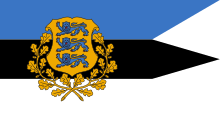
 |
|---|
|
|
|
|
|
|
|
|
|
|
|
|
|
|
|
The president of the Republic of Estonia (Estonian: Eesti Vabariigi President) is the head of state of the Republic of Estonia.[2] The current president is Alar Karis, elected by Parliament on 31 August 2021, replacing Kersti Kaljulaid.[3]
Estonia is one of the few parliamentary republics in which the president is a ceremonial figurehead without even nominal executive powers. The president is obliged to suspend their membership in any political party for the term in office. Upon assuming office, the authority and duties of the president in all other elected or appointed offices terminate automatically. These measures should theoretically help the president to function in a more independent and impartial manner. The president holds office for five years. They may be elected any number of times, but not more than twice consecutively.
In Estonia, the president is elected by the Riigikogu;[4] a candidate must win a two-thirds supermajority to be elected. If no candidate achieves two-thirds support in the Riigikogu after three rounds of balloting, a special electoral body is convened comprising all members of the Riigikogu and elected representatives of all municipalities (at least one representative per each municipality, but not more than 10 representatives depending on the number of citizens with voting rights residing in the municipality). This body chooses between the two candidates with the largest percentage of votes.
While this election process has been criticised, the idea of direct elections does not have enough support in parliament, with only Estonian Centre Party and Conservative People's Party defending it.[5][4][6][7]
The authors of the first Estonian constitution, with memories of the Russian emperors' abuses of power, tried to avoid concentrating too much power in one person's hands by all means possible. This eventually led to a creation of an ultra-parliamentary system. The power of the Parliament (Riigikogu) was practically unlimited. Until 1934, the nominal head of state was the State Elder, (riigivanem), who also served as de jure chairman of the cabinet—officially known as "the Government." However, he could not play a balancing role in the event of conflict between the Parliament and the Government. The State Elder and the Government were completely dependent on the Parliament and could be sacked by it at any time. The functions that are usually vested on a president in parliamentary systems were divided among the speaker of the Riigikogu, the State Elder and the Government.
Estonia's constitution was amended in 1933, instituting a strongly presidential system. The head of state, according to the new constitution, was also called the State Elder, but this time was vested with sweeping executive powers. However, it never came into effect as a result of Konstantin Päts's self-coup in 1934. In 1938, another constitution was enacted, and the head of state's title was changed to "President of the Republic." He was given very broad executive power, though he was somewhat less powerful than the State Elder of the 1933 constitution. Konstantin Päts became the first person to bear this title. His term was to last for six years.
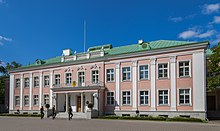
Within days after the Soviet military occupation of Estonia in June 1940, Päts was forced to appoint a Communist-dominated puppet government headed by Johannes Vares, following the arrival of demonstrators accompanied by Red Army troops with armored vehicles to the Presidential palace. The Vares government had actually been chosen by Soviet official Andrei Zhdanov. Following the sham elections in July, president Päts was dismissed from office. Later in July Päts, along with his son, daughter-in-law and two grandsons, was deported to Ufa in Russia.
According to the 1938 constitution, in case the president was ever incapacitated, or was otherwise unable to carry out his functions, his duties were to be assumed by the prime minister under the title "Prime Minister in duties of the President." Following this provision, Vares nominally took over the functions of the president for a few weeks during the Soviet occupation until Estonia was annexed and formally incorporated into the Soviet Union in August 1940. However, during times of war or incapacitation lasting longer than six months, the constitution provides for the election of an acting president by the Electoral Council. In a secret meeting on 20 April 1944, the Electoral Council determined that the appointment of Vares as prime minister in 1940 had been unlawful according to the 1938 constitution. The council elected Jüri Uluots as acting president on 21 April. Uluots appointed Otto Tief as prime minister. Tief was subsequently arrested by the re-occupying Soviet forces in September 1944.
In September 1944, Uluots and the surviving members of the Tief government escaped to Sweden. The day before Uluots died in January 1945, a successor, August Rei, was named to assume the position of acting president. Following Rei's death in 1963, the role passed to Aleksander Warma, then to Tõnis Kint in 1971, then to Heinrich Mark in 1990. In October 1992, Mark handed over his credentials to the newly elected president of the restored republic, Lennart Meri.
After Estonia regained independence, a new constitution was adopted in 1992 that was based on a mixture of the 1920 and 1938 documents. During the drafting of the new constitution, it was initially planned to use the older, more traditional title, State Elder, for the head of state. However, the more modern term "president" was eventually chosen after public consultations. Since the adoption of the 1992 constitution, seven presidential elections have taken place (in 1992, 1996, 2001, 2006, 2011, 2016, 2021). Lennart Meri was elected in 1992 (this election, unlike later ones, had a public round) and re-elected in 1996, defeating Arnold Rüütel both times. Rüütel himself became the next president in 2001. In 2006, Toomas Hendrik Ilves won the election in the electoral assembly, and he was reelected by the parliament in 2011. In 2016, Kersti Kaljulaid was elected president only after the parliament, and then the electoral assembly too, had failed to elect one, and the election had passed back to the parliament. Alar Karis was elected president by the parliament in 2021.
The president of the Republic of Estonia:
Unlike their counterparts in other parliamentary republics, the president is not even the nominal chief executive. Rather, the Constitution explicitly vests executive power in the Government.
| No. | Portrait | Name | Took office | Left office | Party | Birth and death |
|---|---|---|---|---|---|---|
| 1 | 
|
Konstantin Päts | 24 April 1938 | 23 July 1940 | b. 23 February 1874, Tahkuranna d. 18 January 1956, Burashevo, Kalinin Oblast, USSR | |
| 1938 – I round – elected by the Electoral Assembly (parliament and municipal appointees) with 219 of 238 votes (92.0%). | ||||||
| 2 | 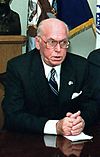
|
Lennart Meri | 6 October 1992 | 8 October 2001 | Pro Patria National Coalition | b. 29 March 1929, Tallinn d. 14 March 2006, Tallinn |
| 1992 – II round – elected by the parliament with 59 of 101 votes (58.4%). 1996 – V round – elected by the Electoral Assembly (parliament and municipal appointees) with 196 of 372 votes (52.7%). | ||||||
| 3 | 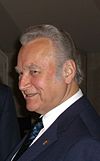
|
Arnold Rüütel | 8 October 2001 | 9 October 2006 | People's Union of Estonia | b. 10 May 1928, Laimjala Parish, Saare County |
| 2001 – V round – elected by the Electoral Assembly (parliament and municipal appointees) with 186 of 366 votes (50.8%). | ||||||
| 4 | 
|
Toomas Hendrik Ilves | 9 October 2006 | 10 October 2016 | Social Democratic Party | b. 26 December 1953, Stockholm, Sweden |
| 2006 – IV round – elected by the Electoral Assembly (parliament and municipal appointees) with 174 of 345 votes (50.4%). 2011 – I round – elected by the parliament with 73 of 101 votes (72.3%). | ||||||
| 5 | 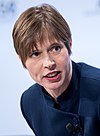
|
Kersti Kaljulaid | 10 October 2016 | 11 October 2021 | Independent | b. 30 December 1969, Tartu |
| 2016 – VI round – elected by the parliament with 81 of 101 votes (80.2%). | ||||||
| 6 | 
|
Alar Karis | 11 October 2021 | Incumbent | Independent | b. 26 March 1958, Tartu |
| 2021 – II round – elected by the parliament with 72 of 101 votes (71.3%). | ||||||
|
Heads of state and government of Europe
| |||||||
|---|---|---|---|---|---|---|---|
| Heads of state |
| ||||||
| Heads of government |
| ||||||
| |||||||